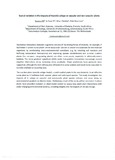Abstract:
Facilitative interactions between organisms are one of the driving forces of diversity. An example of facilitation is where nurse plants create favourable habitats in severe environments for less-tolerant organisms by ameliorating micro-environmental conditions (e.g. by retaining soil moisture and buffering temperature fluctuations) and improving species establishment and survival. Cushion plants (i.e. compact, low-growing plants) are often nurse plants, especially in abiotically-severe habitats. The stress gradient hypothesis (SGH) posits that positive interactions increasingly exceed negative interactions along increasing stress gradients. These predictions have generally been supported, although the SGH still requires refinement in some systems and needs to be expanded to consider multiple co-occurring taxa.
The cushion plant Azorella selago Hook.f., a well-studied plant in the sub-Antarctic, is an effective nurse plant as it facilitates both vascular plants and arthropod species. This study investigates the impacts of A. se/ago on vascular and nonvascular plant species richness and cover along an environmental gradient on Marion Island. Preliminary result of the study will be presented. Cushion plants have provided ecologist an ideal model system to assess how plant-plant interactions shift under changing environmental severity, providing insights into the impacts of climate change.

